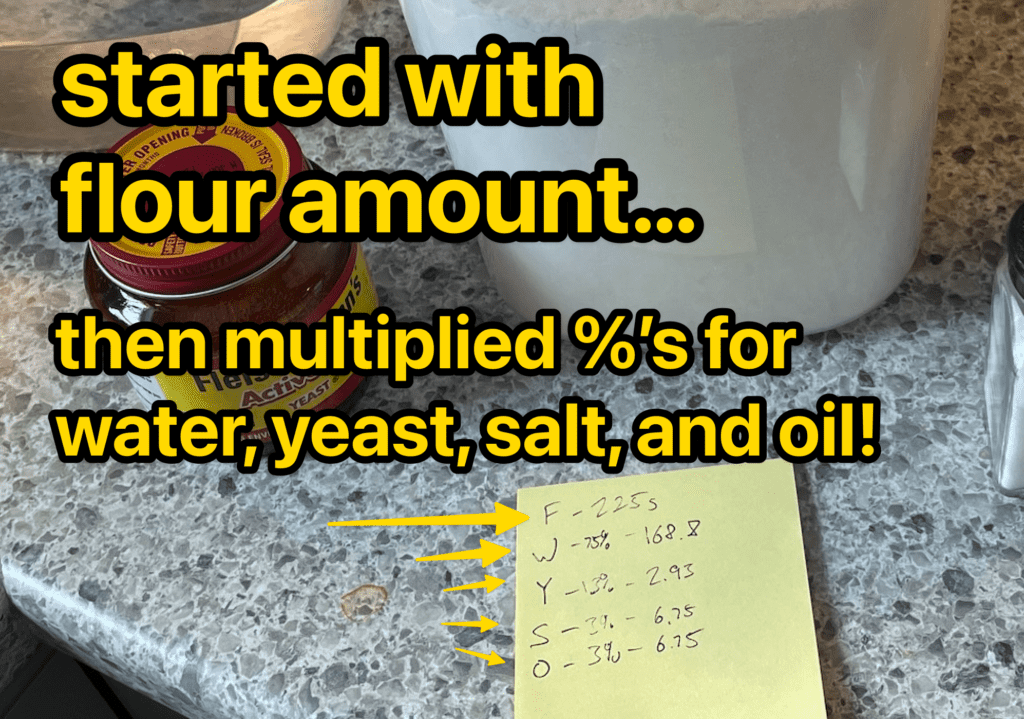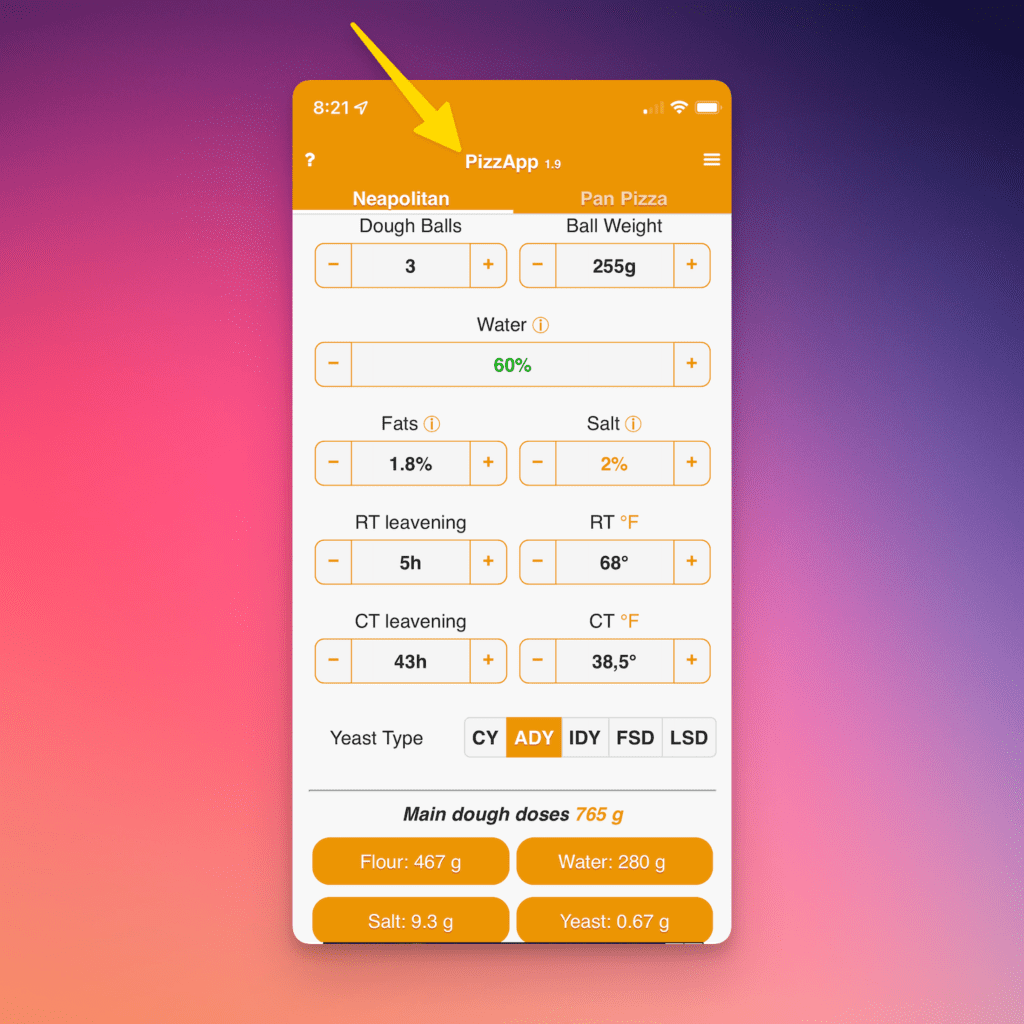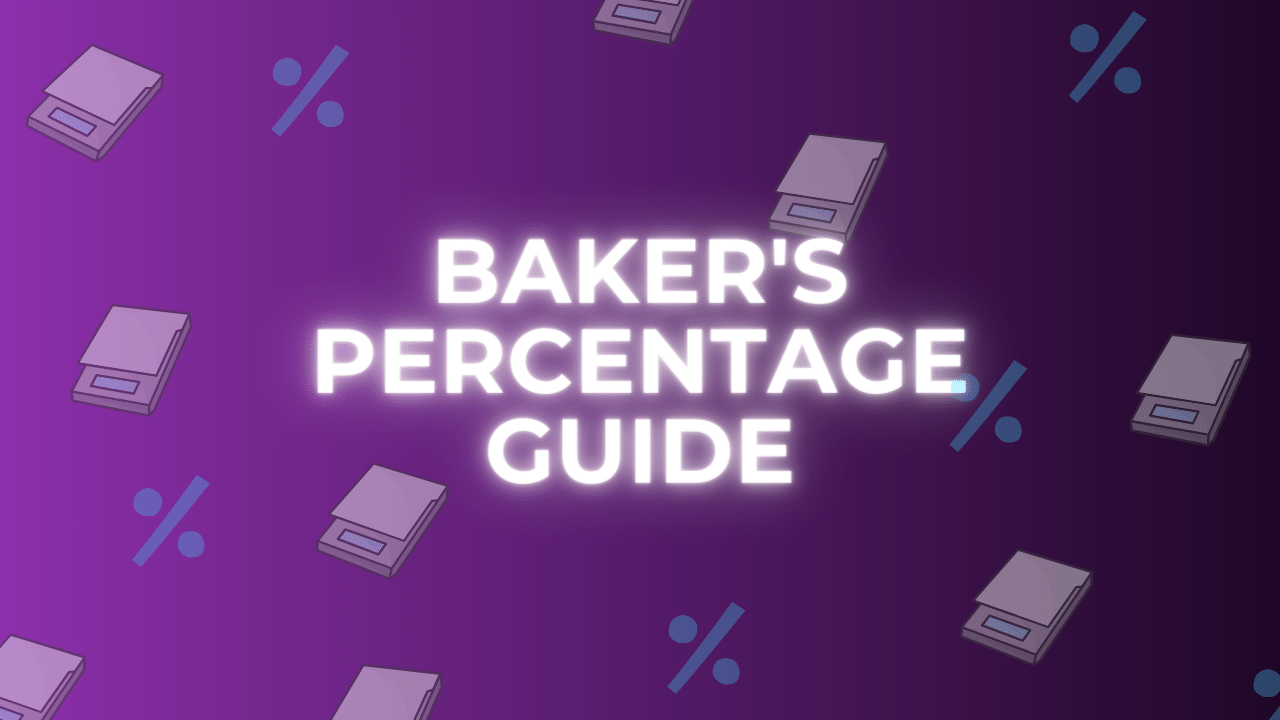To make good pizza, you need to understand baker’s percentage math.
“Math??? That’s for like–ya know–students and stuff?”
Don’t worry pizza nerd 😉.
It’s surprisingly easy (and SUPER helpful for making pizza).
What is Baker’s Percentage? (Definition)
Baker’s percentage is a simple math formula used to calculate the proportion of an ingredient–relative to the amount of flour used in a recipe.
A baker’s percentage recipe is usually written in percentages.

Example:
- 65% water
- 1.2% yeast
- 5% salt
To calculate baker’s percentage, you multiply the percentages listed TIMES the amount of flour you use!
- If you use 500g of flour, you’d 325g of water (500 x 65%).
- If you use 600g of flour, you’d use 390g of water (600 x 65%).
All baker’s percentages begin with flour at 100%.
The beauty of this system is that you can quickly scale recipes up and down and add or remove ingredients WITHOUT changing the basic structure of the recipe you wish to make.
It’s super useful for making pizza!
How Is Baker’s Percentage Useful?
Here are the benefits of using it:
- Easily Scale Recipes
- Evaluate Recipes
- Share Recipes
- Eliminate Food Waste
- Create Consistent Results
Scale Recipes
With baker’s percentages, you can easily alter the quantity of dough you wish to make. Do you want to make two ten-inch Detroit pizzas or four eight-inch Neapolitan crusts? Baker’s percentages help you turn percentages into weighted measurements based on the type and amount of pizza you wish to make.
Evaluate Recipes
By reviewing baker’s percentages, you can determine if a recipe is dry, wet, salty, or sweet simply by glancing at the ratios of each ingredient. You can also predict the rising time and crunchiness.
Share Recipes
It’s easy to share your baker’s percentages with other pizza nerds.
For example, my famous Detroit-style pizza recipe is:
| Flour | 225g for an 8×10 pan (100%) |
| Water | 75% |
| Yeast | 1.3% (if ADY, you might need less with IDY) |
| Salt | 3% |
| Oil | 3% |
Easy to share. Now you can use those percentages for a party–or just for 1 pizza.
Send a baker your percentages, and they can make as much or as little pizza as they want.
Eliminate Food Waste
Bakers are familiar with baker’s math and can easily adapt recipes for the exact amount of pizza they wish to make. Imagine you have one eight-inch pizza pan, but your friend sends you a recipe for a twelve-inch pie.
How do you alter the recipe to fit your pan? That’s incredibly difficult to figure out. Luckily, baker’s math eliminates that complexity. If you send your friend your baker’s percentage, they can create the perfect-sized dough ball by calculating the precise weight of each ingredient.
Create CONSISTENT Results
Baker’s math eliminates the guesswork.
The precise measurements calculated by baker’s percentages ensure consistent pizza results each time you bake.
How Do You Calculate Baker’s Percentage?
To calculate the baker’s percentage, start with an amount of flour (usually expressed in grams). You can think of this as “100%.”
Then, following the % recipe, add other ingredients as a percentage of that amount.
Here is the baker’s percentage formula:
[Starting Flour weight] x [ingredient percentage] = how much of that ingredient you use.
Example:
- 500g flour x 65% water = 325g water.
- 500g flour x 1.3% yeast = 6.5g yeast
- 500g flour x 5% salt = 25g salt
(Don’t forget that you can simply move the decimal two places to the left to multiple a percentage. I.e. “500 x .65” is “500 x 65%”)
Baker’s Percentage Examples
Example 1 – NY style of Neapolitan pizza
Here’s my go-to recipe for NY style:
- 60% water
- 2% salt
- 1.8% oil
- 1% sugar
- 0.15% active dry yeast
- 48hr cold proof
- 470g flour makes three 12-inch(ish) pizzas
Let’s say you want to try my recipe, but really only want TWO small pizzas. You decide to start with 440g of flour, so you’ll multiply THAT number by the percentages listed.
- Flour – 440g
- Water – 264g (60%)
- Salt – 8.8g (2%)
- Oil – 7.9g (1.8%)
- Sugar – 4.4g (1%)
- Yeast – 0.66g (0.15%)
Although I fully recommend a GREAT digital scale, if you don’t have one that accurately measures to the 1/100th gram, you can probably round those numbers and be ok.
Example 2 – Detroit-Style Pizza
Here’s my go-to baker’s percentage for Detroit-style:
- 75% water
- 3% salt
- 3% oil
- 1.3% active dry yeast
- 5-hour room temperature proof
- 225g makes one 8×10 pizza
You’re hosting a dinner party (and have three 10×10 pans, which are a bit larger than mine!). You decide you’ll start with 750g of flour (225 x 3 is 675, PLUS a little extra for the bigger pans).
- Flour – 750g
- Water – 562.5g
- Salt – 22.5g
- Oil – 22.5g
- Yeast – 9.75g
Easy!
What do pizza calculators do?
Pizza calculators usually allow you to adjust the amount of pizza you’d like to make–and they make these % calculations for you!
Most pizza calculator apps start with 2 variables:
- number of doughballs
- doughball weight (in grams)

This usually gets a starting flour amount, and they also allow you to choose the percentages for salt, oil, sugar, etc.
Personally, I use the app titled “Pizzapp,” available on your mobile phone! It’s by far my favorite.
How Do I Convert a Recipe to Baker’s Percentage?
What if you make a great pizza recipe, and want to convert it to Baker’s percentage to use later?
To determine the baker’s percentage for bread, pizza dough, or other baked goods, follow these steps:
- Take the ingredient weight (if in grams) OR amount (if in volume, i.e. “cups” or “tablespoons”)
- IF USING VOLUME (cups, Tbsp, etc) = CONVERT all ingredients to the same measurement. I.e. convert tablespoons to cups, etc.
- Divide the weight of that ingredient by the weight of the flour.
- Multiply the calculated weight of that ingredient by 100. Multiplying by 100 provides the weight as a percentage.
To calculate the percentage of water in a recipe:
- Imagine you begin with 1,000 grams of flour. Now you want to add 600 grams of water. To calculate the baker’s percentage, use the following formula:
- 600 grams of water ÷ 1,000 grams of flour = 0.6
- 0.6 x 100 = 60% hydration
To calculate the percentage of salt:
- 20 grams salt ÷ 1000 grams flour = 0.02
- 0.02 x 100 = 2% salt
Baker’s Percentages F.A.Q.s
What is the Difference Between Baker’s Percentage and Regular Recipe Measurements?
Many recipes use measuring cups and spoons to measure ingredients, but experienced bakers use baker’s percentages to calculate the precise weight of each ingredient. Start with flour at 100%, then measure other ingredients as a percentage of that amount.
Are Baker’s Percentages Better Than Recipes?
Baker’s percentages provide advantages over standard recipes. When using baker’s percentage, you’ll create easy-to-scale, share, and evaluate formulas.
What is the Formula for Baker’s Percentage?
The baker’s percentage formula works as follows:
[Starting Flour weight] x [ingredient percentage] = how much of that ingredient you use.
What are Baker’s Percentages for Pizza?
Baker’s percentages are a mathematical formula for determining the correct proportion of an ingredient relative to flour. Baker’s percentages for pizza include calculations to determine the flour, water, yeast, salt, and oil required to make dough.

